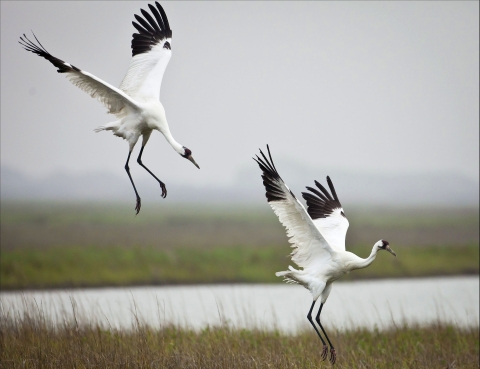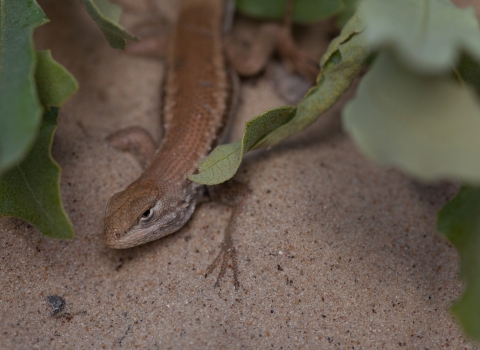Every year endangered whooping cranes migrate 2,500 miles from their breeding grounds in Wood Buffalo National Park in Canada to Aransas National Wildlife Refuge and surrounding habitats, where they spend the winter. Once they have arrived, wildlife biologists with the U.S. Fish and Wildlife Service (Service) survey the birds by air and analyze population trends.
Preliminary data analysis of aerial surveys of the Aransas-Wood Buffalo whooping crane population conducted in January 2023 indicated 536 whooping cranes, including 88 juveniles, in the primary survey area (approximately 160,125 acres) centered on Aransas National Wildlife Refuge. The last survey from winter 2021-2022 estimated 543 whooping cranes, indicating the population has remained stable over the last two years.
An additional 14 birds were recorded outside the primary survey area during the survey, based on data from Texas Whooper Watch, eBird reports, iNaturalist reports, a whooping crane GPS tracking study, and aerial surveys conducted in the secondary survey areas. This marks the sixth year that the population has topped the 500 mark, although a survey was not conducted during winter 2020-2021 due to COVID-19 concerns.
Whooping cranes are one of the rarest birds in North America and are highly endangered. Cranes have been documented to live more than 30 years in the wild. Adults generally reach reproductive age at four or five years, and then lay two eggs, usually rearing only one chick.
Due to extensive conservation efforts of federal, state and private landowners, whooping crane populations have increased significantly. When the bird was listed under the Endangered Species Act in 1967, only 50 of the birds existed – with 43 wintering at Aransas National Wildlife Refuge and seven in captivity. The long-term annual population growth rate for whooping cranes has averaged 4.34 percent.
Biologists plan to conduct the next survey in January 2024.
To view or download the report, visit our website. More information about the survey and whooping cranes can also be found on the Aransas National Wildlife Refuge website or by calling the Aransas National Wildlife Refuge Visitor Contact Station at: 361-349-1181.
This announcement comes as the ESA turns 50 years old in 2023. Throughout the year, the Department of the Interior is celebrating the ESA’s importance in preventing imperiled species extinction, promoting the recovery of wildlife and conserving the habitats upon which they depend.




